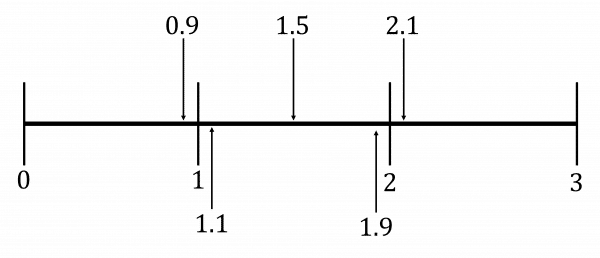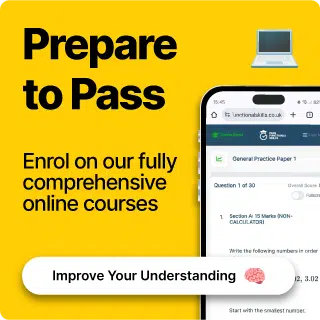Functional Skills: Decimal Basics
Decimal Basics
Not every number is a whole number. Decimals are used to represent numbers that are between the whole numbers, for example 1.5, which is halfway between 1 and 2.
The dot between the numbers is called a decimal point.
The whole number part is to the left of the decimal point, and the decimal part is to the right of the decimal point.
The entire number lies between the whole number part and the next whole number, and where exactly in that space it falls depends on the digits after the decimal point.
If you are saying a decimal number out loud, say the whole number part normally, then say “point” for the decimal point, then say each number to the right of the decimal point as an individual digit.
For example, 22.54 would be said as “twenty two point five four”.
Make sure you are happy with the following topics before continuing.
The Value of Decimals
As mentioned above, the value of the digits after the decimal point determines how far along between the whole numbers a decimal is. We can see this with lots of examples.
0.9 is slightly smaller than 1
1.1 is slightly bigger than 1
1.5 is halfway between 1 and 2, so it is bigger than 1.1
1.9 is only slightly smaller than 2, so it is bigger than both 1.1 and 1.5
2.1 is slightly bigger than 2

Follow Our Socials
Our Facebook page can put you in touch with other students of your course for revision and community support. Alternatively, you can find us on Instagram or TikTok where we're always sharing revision tips for all our courses.
Decimals in Money and Measuring
Decimals can be used to show money in pounds and pence, for example £1.15 means 1 pound and 15 pence.
Money always has two decimal places, so for 3 pounds and 40 pence, you would write £3.40, not £3.4
Other measurements do not always have two decimal places, like length.
4.1 m means 4 metres and 1 tenth of a metre. Since 1 tenth of a metre is 10 centimetres, this is equivalent to 4 metres and 10 centimetres.
When there are two decimal places on a length, it is easy to see how many metres and centimetres there are: 12.35 m is 12 metres and 35 centimetres.
There are many other types of measurement that use decimals, that you will come across in the Measures, Shape and Space section of the course.
Ordering Decimals
To order decimals, use the following method:
Step 1: Line the decimals up at the decimal point.
Step 2: Order the whole number parts, ignoring the decimals.
Step 3: If two numbers have the same whole number part, look at the first digit after the decimal point and order using that.
- If the first digit is the same, look at the second digit.
- If the second digit is the same, look at the third digit, and so on until all the numbers are ordered.
- If there are no digits left in a decimal number, you can treat it as if all other digits are zeroes – e.g. 12.13 is greater than 12.1 because we can treat 12.1 as equal to 12.10 and 3 is greater than 0.
- If you find it easier, you can manually add these zeroes to make all the numbers have the same number of digits after the decimal point.
Note: Some questions ask you to find the largest or smallest number out of a list of decimals. To answer these, you can order the numbers then select the number at the correct end of your ordering.
Example 1: Decimals in Money
A new video game has just been released. Tom buys it from a shop for £32.99. How many pounds and how many pence is this?
[2 marks]
The whole number before the decimal is 32, so there are 32 pounds.
There are two digits after the decimal point, so we can just read off the number of pence – there are 99 pence.
Example 2: Ordering Decimals
Write these decimals in order to find the smallest.
1.1,2.4,3.3,2.96,1.14,2.2
[3 marks]
First, order the whole number parts:
1.1,1.14,\;\;\;2.4,2.96,2.2,\;\;\;3.3
There is only one number beginning with 3, so we know this must be the largest number.
Let’s consider the 2s next. The first digits after the decimal point are 4, 9 and 2, of which 2 is the smallest, 4 is the next smallest, and 9 is the largest, so these must be ordered as
2.2,2.4,2.96
Finally, let’s consider the 1s. The first digit after the decimal point is 1 in both, so we need to look to the second digit. 1.1 does not have a second digit after the decimal point, so we act as if the second digit after the decimal point is 0. The second digit after the decimal point in 1.14 is 4, which is larger than 0, so the order must be
1.1,1.14
Putting it all together, we can write our final order:
1.1,1.14,2.2,2.4,2.96,3.3
So, 1.1 is the smallest.
Functional Skills: Decimal Basics Example Questions
Question 1: What is 25.41 in words?
[1 mark]
We say the whole number part normally – “twenty five”.
For the decimal point we say “point”.
For the digits after the decimal we read them out one by one – “four one”.
Putting it all together gives:
“twenty five point four one”
Question 2: Ahmed’s weekly shop totals £24.50. What is this in pounds and pence?
[2 marks]
The whole number part is the pounds, so there are 24 pounds.
There are two decimal places after the decimal point, so we can just read off the number of pence – there are 50 pence.
Question 3: Write the following as a number of metres and a number of centimetres:
a) 3.14 m
b) 122.95 m
c) 9.3 m
[6 marks]
a) The whole number part is the metres, so there are 3 metres, and there are two decimal places so we can just read off the number of centimetres – there are 14 centimetres.
b) The whole number part is the metres, so there are 122 metres, and there are two decimal places so we can just read off the number of centimetres – there are 95 centimetres.
c) The whole number part is the metres, so there are 9 metres. There is only one decimal place, so we cannot read off the number of centimetres. We can, however, add a 0 onto the end, just like when we are ordering decimals, to make it have two decimal places. We get 9.30 m and can read off that there are 30 centimetres.
Question 4: Put these decimals in ascending order.
0.12,0.2,0.156,0.154,0.11
[2 marks]
The whole number part for all of these is 0, so we have to skip straight to the first digit after the decimal point. The only first digit that is not 1 is 0.2, which has a first digit of 2, which is greater than 1. So 0.2 is the biggest number.
For the rest, we must turn to the second digit. 0.11 has a second digit of 1, so is the smallest. 0.12 has a second digit of 2, so is next. 0.154 and 0.156 both have a second digit of 5, so we have to look to the third digit. 4 is less than 6, so 0.154 is less than 0.156.
Putting it all together, we get:
0.11,0.12,0.154,0.156,0.2
Question 5: Ellie, Jonathan and Samantha all buy the same branded cereal from three different supermarkets.
Ellie pays £2.15
Jonathan pays £1.99
Samantha pays £2.04
Who gets the worst deal?
[3 marks]
The “worst deal” means the highest price in this circumstance. So we have to order the prices, then pick the highest.
This is the same as ordering decimals, we just get rid of the pound sign.
So we need to order 2.15,1.99,2.04
First, order the whole number parts. 1.99 has a whole number part of 1, while the others have a whole number part of 2, so 1.99 is the lowest.
Now look to the first digit after the decimal point. 2.04 has a first digit of 0, while 2.15 has a first digit of 1, so 2.04 is less than 2.15 so 2.15 is the largest number.
This means that £2.15 is the worst deal.
So, Ellie got the worst deal.
Specification Points Covered
EL3.8 – Read, write and use decimals up to two decimal places







